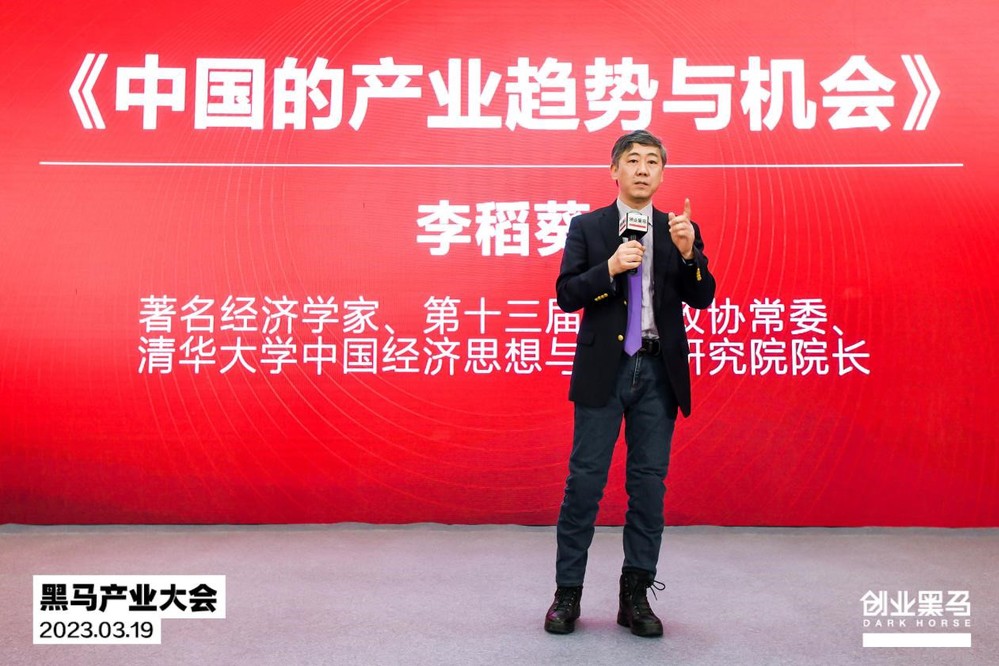David Daokui Li: Top 5 growth industries to spur China’s economic development over next 5-10 years
This news story was originally published March 19, 2023, in Chinese on China Securities Net (www.cnstock.com) by Shanghai Securities News. Written by Wang Yuqing. Translated by ACCEPT. To view the original article, click here.

Photo shows David Daokui Li speaking at the Dark Horse Industry Conference on March 19, 2023. (Photo Credit: Dark Horse Technology Group)
According to an editorial published March 19 on China Securities Net (www.cnstock.com) by Shanghai Securities News, renowned economist and director of the Academic Center for Chinese Economic Practice and Thinking (ACCEPT) at Tsinghua University, David Daokui Li, recently joined the 2023 Dark Horse Industry Conference where he delivered a keynote address focusing on the topic of “Trends and Opportunities for Chinese Industry.” Li stressed that over the course of the next five to ten years, promoting growth and striving for the economy are most likely to become the accepted norm and remain of the highest priority. However, economic development can no longer rely solely on the real estate and infrastructure construction sectors, but must instead be driven by the development of China’s various industries.
When it comes to striving for the economy, Li anticipates that the primary focus will revolve around five key industry areas: 1) carbon dioxide peaking and energy security; 2) the digital transformation of traditional industries; 3) remedying the shortcomings of industries; 4) economic security; and 5) scientific and technological innovation. According to his calculations, these five key industry areas would each be able to generate over a trillion yuan in additional annual output for the country, as well as having important strategic significance for China’s future economic development during the next few decades and beyond.
“Era of relying on the real estate sector to spur economic growth now in the past”
Li stated that if China is to achieve its goals of basically realizing socialist modernization and reaching a per capita GDP on par with the level of moderately developed countries by 2035, the country’s economy will need to continue expanding at an average annual growth rate of 4.61% starting from this year onwards. “For a number of years ahead, we must promote growth and must strive on behalf of the economy. Without an economic base, other aspirations like building up national military strength and international influence will all be relatively difficult to fulfill,” Li said.
How then to strive for the economy and promote growth? In this regard, Li commented that while the real estate and infrastructure sectors have made an appreciable contribution to driving China's economy over the past ten years, that era has for all intents and purposes already run its course. He pointed out that from the beginning of the turn of the century to 2015, China’s real estate industry was contributing on average to 2.5% of the country’s economic growth annually, with this contribution having at present dropped down to below 1%. Thus, apart from a few regions, the real estate sector’s capacity to spur economic growth and improve people's living standards has already diminished to a great extent compared with the past two decades.
It will also be difficult to continue relying on infrastructure to further propel the economy. On the one hand, much of the infrastructure in and between cities across the country is comparatively well-developed (although the density of road networks still needs to be increased in some economically developed areas); on the other hand, the issuance of local debt, an important mechanism for infrastructure construction, has also already reached a relatively high level.
Therefore, Li believes that the key for promoting economic growth moving forward will depend on the country's industries, with the continued development of these industries being the only way to carry out the task of economic upgrading.
“Striving for the economy” hinges on five key trillion-yuan industries
In Li’s estimation, the potential size of the five key industries he mentioned will all grow to reach more than one trillion yuan each.
The first key industry is the carbon dioxide peaking and energy security industry. Li considers there to be four major pathways – “four horses galloping in unison” – that currently define technological developments in the carbon peaking industry, with the question as to which one will be mainstreamed in the future remaining open.
One of these four pathways is battery technologies. Li expects the pace of expansion along this pathway to be comparatively slow and pointed to the challenges involved with quickly ratcheting up growth. At the same time, there has not yet been a revolutionary breakthrough in battery technologies, with the present stocks of lithium, nickel, cobalt and other base metals required for batteries potentially being insufficent to sustain China and the rest of the world’s ongoing energy transformation. The second pathway is hydrogen. The technical obstacles facing this pathway mainly revolve around the high-pressure compression required for hydrogen storage and transportation processes, in additional to the excessively high prices for end-use applications of hydrogen fuel cell technologies. The third pathway is methanol. One way to produce methanol involves synthesizing liquefied hydrogen with carbon dioxide captured from the atmosphere. Methanol is an essential chemical commonly found in the petrochemical industry. In fact, if the scale of methanol production can be expanded and become large enough, there will no longer be any need to import crude oil. Moreover, methanol is easy to store, while the viability of downstream internal combustion engine technologies for methanol have meanwhile already been proven for the most part. The fourth pathway is ammonia. This chemical compound is obtained by synthesizing the hydrogen generated from solar energy production and the nitrogen captured from the atmosphere, with the gas being relatively convenient for storage, transportation and combustion purposes.
“I don't know which of these four pathways will eventually succeed, but at the present moment we must begin to devote a lot more of our efforts towards speeding up the energy transition. Li anticipates that the carbon peaking and energy security sector in China has the potential to continue growing to reach an annual output value of at least five trillion yuan.
The second key industry area for spurring on the economy is the digitalization of traditional industries. Li suggested that all traditional industries will be able to undergo digital transformation, which will permit these industries to unlock and exploit additional incremental value in a highly competitive “red ocean” market environment.
The third top industry trend involves “remedying the shortcomings of industries.” As Li explained, remedying shortcomings” refers to figuring out the weak links within a given industry, namely those critical cost points that tend to have the highest premiums. "I'm not suggesting that foreign technologies can’t be used, it is just that they are very expensive. Once we can make breakthroughs in key technologies, the capacity for industries to increase their profitability will be vastly improved. This is the kind of situation that characterizes many industries around the country.”
The fourth major direction is safeguarding those industries vital to economic security. For example, the volume of nickel produced in China is comparatively low, and yet nickel is an important raw material for stainless steel and lithium batteries, which thus gives rise to certain economic risks. Li noted that the solution to this problem does not necessarily imply ramping up domestic nickel ore production to meet the country’s own needs. Instead, he suggested that China establish its own nickel stockpile to store up the nickel ore supplies needed to maintain normal economic operations for a period of at least six months to a year. Setting up a nickel ore stockpile must be accomplished with the cooperation of the entire industrial chain, with state-owned enterprises along the industrial chain playing a particularly central role to this end. This project will require significant financial support as well as government backing, conceivably also including certain international contributions.
The final key industry area is the field of scientific and technological innovation. When it comes to those industries in the technology sector that are rapidly advancing simultaneously both in China and other countries, such as quantum computing and quantum communications, Li stressed the need to ensure that all the supporting elements are in place to link up the industrial chain from upstream to downstream, which includes the supply of related components at the global cutting-edge. As for those countries that have already successfully created entirely new technologies from zero to one that China has not itself yet mastered, based on the current situation, and in order to guarantee its own security in terms of technology, it is very likely that China will be obliged to go it alone through the same zero to one process.
Li concluded by underscoring that when it comes to spurring on the economy in the years ahead, other than the digitalization of traditional industry, the key industry areas mentioned above will all require China’s “national team” to shoulder an enormous burden of responsibility.




